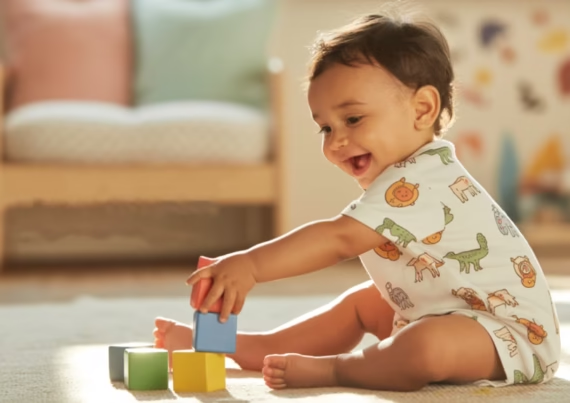Why Label Material is Crucial for Baby Clothing Safety
When considering baby clothing safety, we often focus on the obvious factors like size, style, and fabric. However, one small yet crucial detail is often overlooked – the label material. Have you ever paid attention to those tiny tags sewn into your baby’s clothes? They aren’t just brand identifiers – they play a key role in ensuring your baby’s safety and comfort. Label material directly impacts your baby’s wearing experience and can even determine whether they suffer from skin allergies, scratches, or other accidents. In this article, we’ll dive deep into the significance of label materials, the risks of unsafe labels, and best practices for selecting safe label materials to help parents choose safer clothing for their babies.

With 17 years of experience, petelulu provides a full range of
manufacturing services from design to delivery.
Start from scratch , Create your own brand.
17+
serving top 10 American brands
15+
serving top 10 Australian brands
12+
serving top 10 European brands
Contact us to get the quote.👇
Why Label Material Affects Baby Clothing Safety
-
Labels are not just brand identifiers; they play a crucial role in ensuring your baby’s skin safety.
-
Poorly chosen label materials can lead to skin allergies, rashes, itching, and other discomforts, even causing more severe health problems.
-
The choice of label materials also affects the durability of the label, as labels may become detached or damaged over time, presenting potential hazards.
Key Points:
-
Baby skin is extremely delicate and prone to allergic reactions from rough or chemically-treated label materials. Choosing soft, non-irritating labels helps reduce this risk.
-
Certain poorly made labels can irritate the skin, leading to allergic reactions or severe skin conditions.
-
Label materials should be durable and able to withstand multiple washes, ensuring that labels do not become a potential danger by falling off.

Common Label Materials in Baby Clothing
-
Common label materials include cotton, polyester, satin, etc., each with its pros and cons.
-
Choosing the right label material is not just about comfort but also affects your baby’s skin health.
Key Points:
-
Cotton Labels: Soft and natural, they are less likely to cause allergies, making them ideal for babies with sensitive skin.
-
Polyester Labels: Durable and strong, but may cause skin irritation, especially with prolonged wear.
-
Satin Labels: Attractive but some satin labels may be stiff, causing discomfort for babies.
-
Eco-friendly Labels: With growing environmental awareness, many brands now use organic cotton, non-toxic printing, and natural dyes to make labels, reducing health risks for babies.
Risks of Unsafe Label Materials
-
Inappropriate label materials not only harm your baby’s skin but can also pose a serious safety risk.
-
Loose or sharp-edged labels can become choking hazards.
-
Labels made from unsafe materials might contain harmful chemicals, leading to long-term health problems.
Key Points:
-
Chemical Risks: Many label materials may contain harmful chemicals such as formaldehyde, benzene, etc., which can negatively affect a baby’s skin and respiratory system.
-
Choking Hazards: Improperly fixed labels or poorly cut labels can detach during washing and become choking hazards if ingested.
-
Skin Allergies: Hard or rough labels can trigger allergic reactions, leading to rashes or skin inflammation.
Regulatory Standards and Certifications for Baby Clothing Labels
-
There are strict regulations around baby clothing label materials globally to ensure the use of safe, harmless materials.
-
Certifications such as Oeko-Tex and GOTS help parents identify safe labels.
Key Points:
-
Oeko-Tex Certification: This certification ensures that baby clothing labels are free from harmful chemicals and is a globally recognized safety standard.
-
GOTS Certification: The Global Organic Textile Standard (GOTS) ensures that not only the fabric of the clothing but also the labels meet environmental and health standards.
-
Other Certifications: Regulations like ASTM F963-17 ensure that baby clothing adheres to strict safety standards, giving parents peace of mind about their child’s safety.

With 17 years of experience, petelulu provides a full range of
manufacturing services from design to delivery.
Start from scratch , Create your own brand.
17+
serving top 10 American brands
15+
serving top 10 Australian brands
12+
serving top 10 European brands
Contact us to get the quote.👇
Best Practices for Parents When Buying Baby Clothing
-
How to use label information to choose safe, comfortable baby clothing.
-
Parents should pay attention to label material, attachment methods, and safety certifications.
Key Points:
-
Choose Soft Labels: Opt for labels made from soft natural materials (like cotton) and avoid harsh synthetic fibers.
-
Avoid Unnecessary Labels: Consider buying baby clothes with no labels or “label-free” designs to avoid exposing your baby to unsafe labels.
-
Check Label Attachment: Ensure that the label is securely sewn to prevent it from falling off, avoiding choking risks.
-
Choose Certified Brands: Prioritize brands that carry Oeko-Tex, GOTS, or other safety certifications to ensure the label materials are up to standard.
Conclusion:
Label materials in baby clothing may seem like a small detail, but they play an essential role in ensuring your baby’s safety and comfort. From preventing skin allergies to avoiding choking hazards, the right label material can make all the difference. As parents, choosing safe label materials is an important factor when selecting baby clothes. By following best practices, looking for safety certifications, and choosing the right label materials, you can ensure that your baby wears clothes that are not only stylish but also safe and comfortable. Protecting your baby’s health starts with paying attention to the details!
About the author
Xhiney, founder of Petelulu, brings over 20 years of experience in children’s wear design, production, and international trade. A contributor to Children’s Wear and Junior magazines, Xhiney has spent 17 years working with high-end children’s wear brands in Europe and the U.S., offering expert insights and support.
